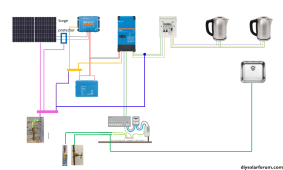brackstone
New Member
- Joined
- Mar 27, 2021
- Messages
- 109
I would like to ask a few questions about earthing grounding and bonding on my system which will be UK based.
To make things clear (hopefully ?) with terminology I will try to specify words and what I mean by them first.
I have an earth connection on all solar panels to a earth rod as shown in pink wires and a surge protector on the DC line to the MPPT. This is all to prevent build up on static and lighting induced surges.
The Victron has a neutral/CPC connection internally to provide the CPC for the AC output which is removed when grid takes over supply to prevent parallel fault paths. So, all connected appliances will have the correct fault path back to inverter for MCB and RCD operation.
My questions are:
To make things clear (hopefully ?) with terminology I will try to specify words and what I mean by them first.
- Earth or earthing connection will be a coper rod in the ground (pink in the diagram).
- Grounding will be the negative from the DC battery (Orange in the diagram).
- CPC (Circuit protective conductor) will be the protective cable on the AC side either the grid supply or the inverter output. Green/yellow normally (Light green in the diagram)
- Bonding will be the water/gas and other metal parts within the building (equipotential zone) (Dark Green in the diagram)
I have an earth connection on all solar panels to a earth rod as shown in pink wires and a surge protector on the DC line to the MPPT. This is all to prevent build up on static and lighting induced surges.
The Victron has a neutral/CPC connection internally to provide the CPC for the AC output which is removed when grid takes over supply to prevent parallel fault paths. So, all connected appliances will have the correct fault path back to inverter for MCB and RCD operation.
My questions are:
- Should I connect the chassis of the MPPT and inverter to the battery negative grounding the system as coloured orange in the diagram. I assume yes to protect against a DC fault to appliance chassis which will them operate the protective device (fuse).
- Should I then connect this same grounding cable (orange) in question 1 to the earth rod to protect the appliance chassis from any static build up? Purple cable in diagram.
- Should I connect the AC – CPC output from the inverter to the same earth rod (blue colour in diagram). Not sure about this one, does the Victron inverter have a constant AC in/out CPC connection in which as I am on a TNC-S system will this not be provided by the grid and main water gas bonding. If this was put in and a fault occurred on the grid side with fault on neutral O/C will the fault path now parallel through the inverter to earth.
- If there is no constant CPC connection within the inverter and an earth rod connection is put in on the AC output side will this cause a potential difference hazard with other equipotential bonded parts within the house like the metal sink.



